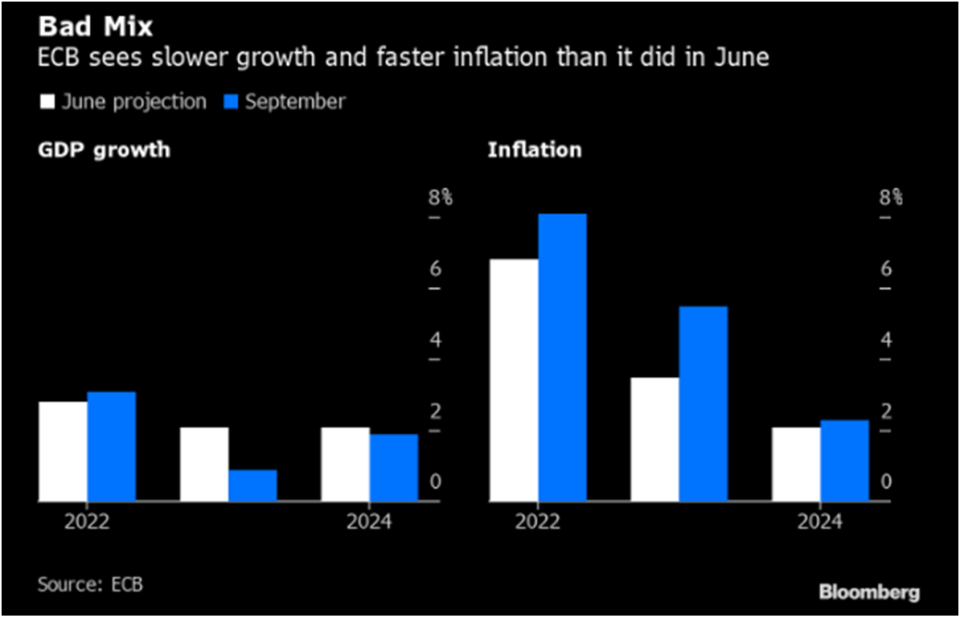Prices & Central Banks – Under Pressure
This article was originally published on ETFTrends.com.
By Natalia Gurushina
Chief Economist, Emerging Markets Fixed Income
DM central banks are in a hawkish mode, and the latest inflation prints suggest that many EM central banks are also not in a position to stop hiking.
Rate Hikes in DM
The euro’s initial “strange” reaction to today’s super-sized (and not fully priced in) 75bps European Central Bank (ECB) rate hike started to look more rational once we checked the ECB’s updated forecasts, which show that European inflation is expected to remain above the target until 2024 (see chart below). This means that the ECB will have to continue frontloading hikes – at a brisk pace. The market is currently clamoring for another large move in October (+82bps), followed by +50bps in December. The next stop in developed markets (DM) is the U.S. Federal Reserve’s (Fed) meeting on September 21, and the Fed Funds Futures point to the repetition of July’s outcome with another 75bps rate hike.
EM Inflation Pressures
The latest inflation prints in emerging markets (EM) suggest that many central banks are not yet in a position to stop hiking. Hungary’s so-called downside inflation surprise was rightly ignored by the market, because headline inflation accelerated to 15.6% year-on-year in August, while annual core inflation surged to whopping 19% (!). The central bank is acting very pro-actively, but there are persistent concerns on the fiscal side, as the pace of the post-election adjustment might be too slow. Mexico’s headline inflation surprised to the upside in August (8.7% year-on-year), and annual core inflation rose above 8% - a strong signal that the central bank will raise the policy rate by 75bps at the end of the month. Chilean prices also rose by more than expected last month (14.1% year-on-year), but the central bank might have room for a smaller hike after a hawkish surprise (+100bps) a few days ago.
EM Asia Policy Reaction
Somewhat better inflation optics in EM Asia allows regional central banks to move in smaller steps. Malaysia opted for a measured 25bps hike today – the third in a row – and the consensus expectation is for more tightening (+126bps in the next twelve months), albeit the pace might be affected by the 2023 budget details (out before the next rate-setting meeting). China’s inflation is out this evening, and the consensus expectation of continuing producer price disinflation and barely changed annual headline inflation should reinforce easing policy bias, as the growth outlook continues to weaken (some sell-side analysts cut their 2022 growth forecasts below 3%).
Chart at a Glance: Big Changes in Europe’s Forecasts

Source: Bloomberg LP.
Originally published by VanEck on 8 September 2022.
For more news, information, and strategy, visit the Beyond Basic Beta Channel.
PMI – Purchasing Managers’ Index: economic indicators derived from monthly surveys of private sector companies. A reading above 50 indicates expansion, and a reading below 50 indicates contraction; ISM – Institute for Supply Management PMI: ISM releases an index based on more than 400 purchasing and supply managers surveys; both in the manufacturing and non-manufacturing industries; CPI – Consumer Price Index: an index of the variation in prices paid by typical consumers for retail goods and other items; PPI – Producer Price Index: a family of indexes that measures the average change in selling prices received by domestic producers of goods and services over time; PCE inflation – Personal Consumption Expenditures Price Index: one measure of U.S. inflation, tracking the change in prices of goods and services purchased by consumers throughout the economy; MSCI – Morgan Stanley Capital International: an American provider of equity, fixed income, hedge fund stock market indexes, and equity portfolio analysis tools; VIX – CBOE Volatility Index: an index created by the Chicago Board Options Exchange (CBOE), which shows the market's expectation of 30-day volatility. It is constructed using the implied volatilities on S&P 500 index options.; GBI-EM – JP Morgan’s Government Bond Index – Emerging Markets: comprehensive emerging market debt benchmarks that track local currency bonds issued by Emerging market governments; EMBI – JP Morgan’s Emerging Market Bond Index: JP Morgan's index of dollar-denominated sovereign bonds issued by a selection of emerging market countries; EMBIG - JP Morgan’s Emerging Market Bond Index Global: tracks total returns for traded external debt instruments in emerging markets.
The information presented does not involve the rendering of personalized investment, financial, legal, or tax advice. This is not an offer to buy or sell, or a solicitation of any offer to buy or sell any of the securities mentioned herein. Certain statements contained herein may constitute projections, forecasts and other forward looking statements, which do not reflect actual results. Certain information may be provided by third-party sources and, although believed to be reliable, it has not been independently verified and its accuracy or completeness cannot be guaranteed. Any opinions, projections, forecasts, and forward-looking statements presented herein are valid as the date of this communication and are subject to change. The information herein represents the opinion of the author(s), but not necessarily those of VanEck.
Investing in international markets carries risks such as currency fluctuation, regulatory risks, economic and political instability. Emerging markets involve heightened risks related to the same factors as well as increased volatility, lower trading volume, and less liquidity. Emerging markets can have greater custodial and operational risks, and less developed legal and accounting systems than developed markets.
All investing is subject to risk, including the possible loss of the money you invest. As with any investment strategy, there is no guarantee that investment objectives will be met and investors may lose money. Diversification does not ensure a profit or protect against a loss in a declining market. Past performance is no guarantee of future performance.
POPULAR ARTICLES AND RESOURCES FROM ETFTRENDS.COM
